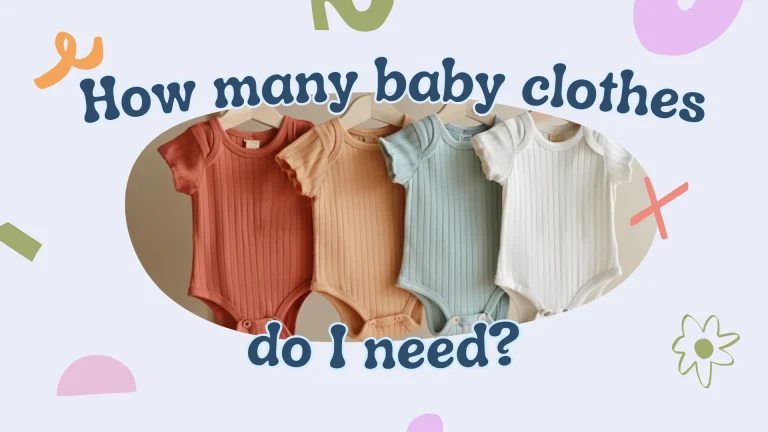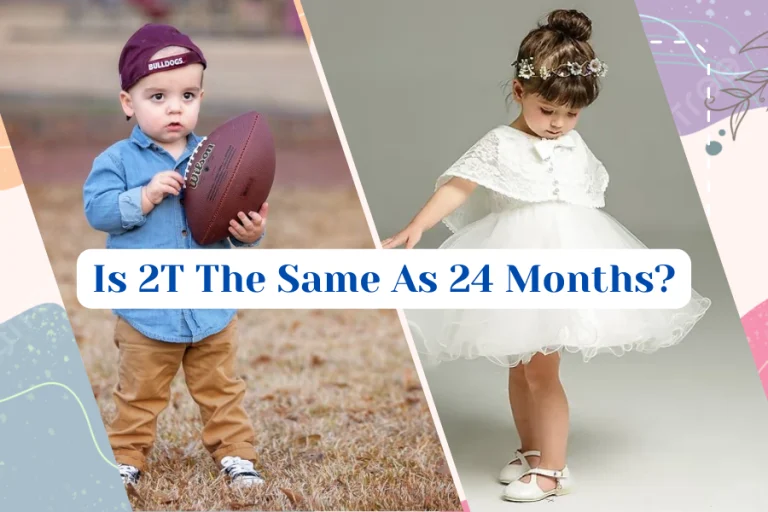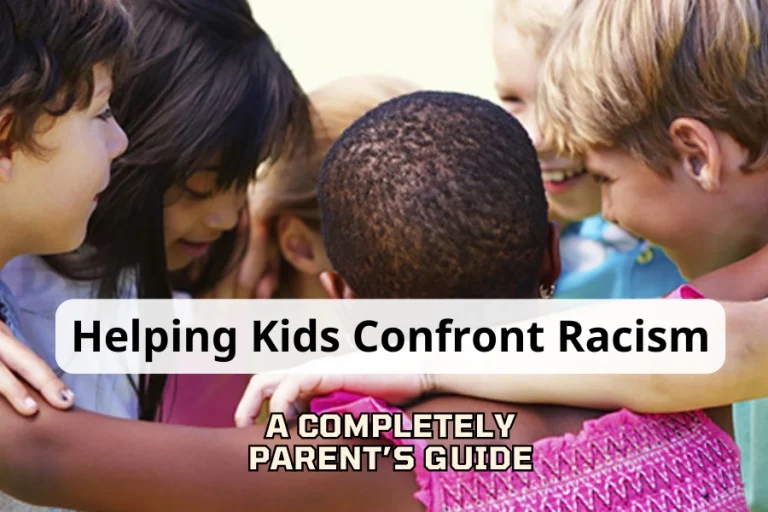
Out of all the schools of educational learning theories, Goddard vs Montessori are of special interest given the distinctive features of their model. However, you may not know much about each and their differences. Goddard vs Montessori comes with different ways of learning and development programs. Goddard concentrates on precise teaching with an academic curriculum, while Montessori approach children are encouraged to learn individually. These different philosophies can result in rather different experiences for your child.
To help you make the right choice, we present to you comprehensive information about Goddard vs Montessori. Thus, by understanding more about each preschool curriculum, it will be easier to identify which of the systems will be suitable for your child.
Goddard School Overview

Founded in 1988, the Goddard Schools have grown into a network of franchising schools with more than 600 schools located across 38 states. The Goddard Schools offers daycare and early childhood educational programs for over 70,000 children from 6 weeks to 6 years old (infants, toddlers, preschool, and kindergarten). Additionally, they offer before and after-school care programs for elementary school children and fun summer programs.
The Goddard Schools prioritize a philosophy they call the FLEX framework. FLEX stands for “Fun Learning Experiences”. The purpose is to allow children to learn most effectively through imaginative play and exploration that spark their natural curiosity.
Their teaching methods center around the STEAM disciplines (Science, Technology, Engineering, Arts, and Mathematics). The teachers create many engaging activities that allow children to have fun while still mastering foundational and necessary skills. You also can find that the setup of a Goddard school is very similar to a traditional preschool classroom.
Goddard Classroom Setup
Goddard Schools adopt a more traditional approach to early learning with classrooms organized by age groups. Activities and lessons are designed to be suitable for each group’s development. Teachers will be there to offer guidance and support while encouraging children to learn through play and exploration.
Toys, puzzles, and games will be integrated into the educational environments. Children will interactive whiteboards to make lessons enjoyable and engaging. Technology is also introduced, with limited use of digital games and tablets.
Learning Programs at Goddard School
Classrooms and lessons at Goddard are thoughtfully designed to cater to children’s needs, ensuring they have fun while learning and growing. By incorporating play-based activities, children are encouraged to explore, create, and develop essential skills.
Below is a detailed classroom program:
- Infants: Develop important skills for your babies (physical, social, and emotional skills)
- First Steps: Support and encourage children to confidently explore and develop new skills, like language skills, and explore new ideas.
- Toddlers: Learn social-emotional skills through activities of playful exploration.
- Get Set: Transition to preschool routines and support continuous development
- Preschool: Start a cooperative learning environment with an interesting and more structured setting.
- Pre-Kindergarten: Opportunities for fun learning and innovation every day
- Junior Kindergarten: Extra year before taking full-day kindergarten or the kids still haven’t met the public-school age allowance.
- Private Kindergarten: Fun learning philosophy while making sure the kids are trained in essential skills for a successful 1st grade.
Goddard Development Milestones
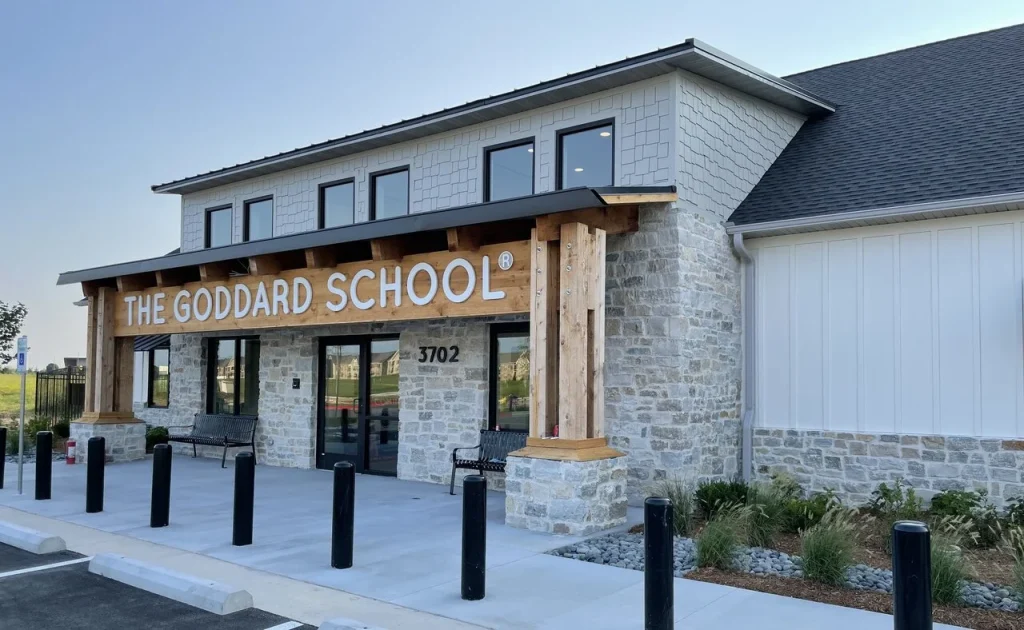
Goddard uses many different tools and teaching methods to help children reach their milestones. Teachers will be responsible for training, observing, assessing, and adjusting the teaching ways accordingly.
Here are some of the developmental milestones that Goddard focuses on:
- Language
- Cognitive
- Physical
- Social and emotional
Goddard School Assessment Methods
Goddard schools assess children’s learning development comprehensively as below:
- Comprehensive Approach: Evaluate various areas, including physical, cognitive, and social-emotional development.
- Frequency: Twice a year with a blend of observation, documented activities, and parent feedback allows for a well-rounded picture.
- Benefits: Teachers can adjust teaching methods to be suitable for each child’s specific needs. The Goddard community also plays an important role in developing children’s social skills. Children learn to work in groups and interact with others in a safe and supportive environment.
Tuition at Goddard School
It’s important to note that tuition for The Goddard Schools varies depending on the age of the child as well as the location of the school. Therefore, to get an exact quote, you can contact directly your preferred Goddard School for details.
However, below is the general cost range at Goddard School for your reference:
- For Infants: around $1,500 – $1,650
- For Toddlers: around $1,300 – $1,600
- For Preschool & Kindergarten: around $1,200 – $1,500
Besides school tuition, there are also other costs, like costs for camping or food programs throughout the year.
Pros & Cons
- Pros:
Goddard offers traditional classrooms. This will help the children can help easy transition to other traditional elementary schools.
The teachers of Goddard Schools are highly trained and professional. They can help your children with knowledge as well as know how to encourage kids to learn and explore positively
- Cons:
The tuition can be too expensive for some parents.
Montessori School Overview
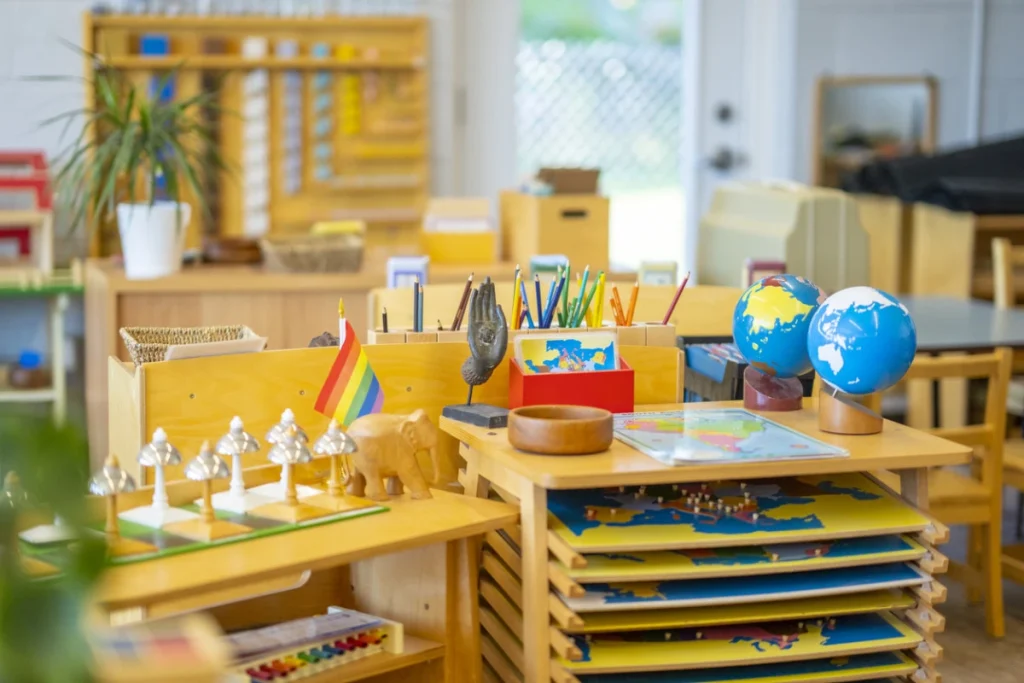
Montessori schools, as an educational model, are closely associated with the Montessori Method. This 150-year-old method was developed by Maria Montessori, a practical physician, educator, and scientist in the early 20th century.1 It is based on the self-paced educational method in a multi-age classroom. Your kids will learn and progress at their own speed there. The teachers will be a great guide and allow the kids to self-discovery.
The main focus of Montessori is to follow the child’s learning, and hands-on activities as well as develop practical life skills. Most Montessori schools are open for children from 3 years old to 6 grade (preschool and elementary stage). While some can continue to secondary and even high school. However, you can send your babies to Montessori Schools earlier, when they are 3 months old.
Montessori Classroom Setup
Montessori classrooms are places where children can learn and engage in small groups or do independent activities on rugs or small tables. Designed to be peaceful and orderly, these classrooms focus on hands-on learning and exploration with many educational equipment. Children are encouraged to work and learn at their own speed. Teachers will provide guidance and help as needed.
Learning Programs at Montessori Schools
Montessori Schools have interesting learning programs. Most of them will start for 3 to 6-year-old children. Here are the general programs:
- Infants Program (3 to 18 months): Mainly focuses on providing a nurturing environment for babies.
- Toddlers Program (18 months to 3 years): The kids will learn about foundational skills and all that they’ll need before starting school. They also learn how to work in a group as well as how to interact with each other.
- Preschool Program (3 to 6 Years): Have specifically Montessori equipment designed to help your child learn as well as build self-construction. The kids will learn with the support of maps, globes, collections of pictures, songs, landforms, learning towers, and much more.
The biggest goal of this stage is to encourage kids to have a love of studying. So, each child can choose their work, and no need to follow any rule or order. The child will learn what they like, this will make them enjoy learning and discovering.
- Elementary Program (6 to 12 years): The classrooms in primary school programs are divided into 2 stages: Lower primary – for grades 1 to 3 and Upper – primary for grades 4 to 6.
The children will join a multi-age classroom and learn with the same teachers through the years. Children will learn in small groups with a research style. The lessons are designed to train children to develop their reasoning abilities as well as the arts of life. The subjects include language, mathematics, geography, history, biology, science, art, and music.
Montessori Development Milestones

Montessori schools use various hands-on materials to help kids learn and discover things as they like. The milestones of Montessori are quite different from Goddard’s:
- Sensorial
- Language
- Mathematical
- Social and emotional
Montessori School Assessment Methods
Unlike Goddard, Montessori schools assess the children with both formal and informal methods:
- Formal & Informal Assessment: Periodic formal assessments are used to evaluate children’s specific skill mastery. Informal assessments are made from observations and anecdotal notes to create a portfolio of the kid’s development progress.
- Benefits: Allow teachers to track individual growth over time, as well as personalize learning paths and plans for each child. In Montessori, community is the foundation for children’s independence and self-esteem. Children learn to respect and care for others, thereby building a strong sense of community and connection with the world around them.
Tuition at Montessori School
Similar to Goddard schools, the fees will vary based on the location of the school. Below are the general costs of the full-day program at Montessori:
- For Infants: around $1,220 – $1,430
- For Toddlers: around $1,060 – $1,260
- For Preschool & Kindergarten: around $1,260
- For Elementary: around $1,290 – $1,500
Pros & Cons
- Pros:
Unique and creative learning programs encourage self-confidence and personal responsibility
The children are inspired to go beyond, learn new things, and explore the world
- Cons:
Similar to Goddard, the cost of Montessori is too high. This makes many parents not be able to afford it.
Because of Montessori’s special learning approach, the children can face difficulty if changing to the traditional education program. 2
The Differences Between Goddard vs Montessori
Below is a capture of differences between Goddard vs Montessori for easy catch-up:
| Factors | Goddard | Montessori |
| Philosophy | FLEX – Fun Learning Experiences | Montessori method |
| Learning approach | More traditional way with well-balanced subjects Structured and specific curriculum Provide many learning materials and fun activities for children | Unique and creative way Allow children to learn in their own way at their own pace. Exploration & hands-on learning curriculum Provide a good learning environment with equipment |
| Age | 6 weeks to 6 years (Infants to Kindergarten) | 3 months to 12 years (Infants to Elementary) |
| Assessment Method | Comprehensive assessment approach Evaluate twice a year | Periodic formal assessment Informal assessment to create a portfolio |
Goddard vs Montessori: How To Choose The Right School For Your Child?

No one knows your child better than you. Depending on your kid’s personality and your navigation, you can consider whether Goddard or Montessori is suitable.
You should take a tour to find out more about the school as well as help you to make the right decision. Watching the classroom’s activities, watching how teachers interact with the children, and discussing with the director are the best ways you can know whether that school is good for your kid or not.
Additionally, you can consider based on our analysis of the pros and cons of each school for better choice.
Bottom Line
Goddard vs Montessori – both systems offer unique benefits, and the best choice depends on the individual needs and learning styles of each child. Goddard schools focus on a structured, play-based curriculum while Montessori schools prioritize self-directed learning and a child-centered approach. Parents can make informed decisions that align with their educational values and their child’s developmental needs.
Sources
- Biography of Dr. Maria Montessori | Montessori Australia. (n.d.). https://montessori.org.au/biography-dr-maria-montessori
↩︎ - What is Traditional Programs | IGI Global. (n.d.). https://www.igi-global.com/dictionary/traditional-programs/68117
↩︎

